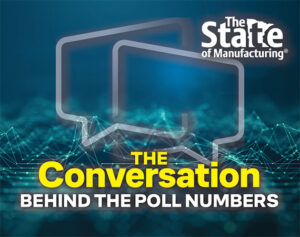Enterprise Minnesota’s Owatonna Peer Council had great interest in learning more about the impending launch of Minnesota Paid Leave (MPL). When word got out the next meeting would cover that topic, interest exploded, and the meeting drew 45 manufacturing executives from around southern Minnesota.
With MPL set to launch on Jan. 1, Enterprise Minnesota invited Sarah Dahl, an ancillary benefits consultant with Marsh McLennan Agency in Minneapolis, to share her insight with all manufacturers in the area, not just Peer Council members.
“It’s more important than ever to help companies understand the requirements,” says Bob Kill, Enterprise Minnesota president and CEO. “This law is extraordinarily complex, and manufacturers are hungry for insight on what it takes to comply.”
Nuts and bolts
The Minnesota Legislature established MPL in 2023 to allow employees up to 12 weeks of paid medical leave and 12 weeks of paid family leave, with a cap set at 20 weeks between the two. Medical leave covers an employee’s personal serious health condition — such as surgery, cancer treatment, or childbirth — that is substantiated by a medical provider.
Family leave covers family-related needs, including bonding with a new child, caring for a seriously ill loved one, taking safety leave, or supporting a deployed military family member. Again, an authorized professional must verify the reason for the leave and the necessary duration.
Most employers with staff working in the state, regardless of company size, must offer paid time off for qualifying reasons. The law excludes federal employees, some seasonal hospitality workers, independent contractors, and the self-employed.
Employees who take approved leave will receive payments to reduce the impact of lost pay during their absence from work. The benefit calculation starts at 90% pay replacement and grades down to 55%, but the maximum benefit is the state average weekly wage ($1,423 as of Oct. 1, 2025). To qualify, employees must have earned at least 5.3% of Minnesota’s average annual wage in the previous year, roughly $3,700 for this year.
The legislature jumpstarted the process by allocating $668 million in benefits funding and $128 million for setup costs. The program is expected to distribute $1.6 billion in benefits and handle roughly 132,000 claims in its first year.
To cover mandatory claims, employers can enter a Minnesota state-run program or obtain private insurance coverage from a state-approved provider. In either case, claims will be reviewed and paid by the third party — either the state or the insurer — not the employer directly.
Employers are quickly approaching several key deadlines and will need to decide soon which avenue they will take to ensure compliance with the new law. The Minnesota Department of Employment and Economic Development, which is overseeing implementation of MPL, has indicated that employers who want private plan approvals for a Jan. 1 effective date should submit their private plan applications to the state by Nov. 10.
Securing private coverage is a multi-step process for companies. “Employers should act now. Don’t wait for the deadline,” Dahl advises. Employers should work with their benefits advisors in securing quotes and navigating the private plan process.
Brian Adamek, a partner and financial planner with E-Wealth Partners in Minnetonka, didn’t attend the Peer Council meeting. However, he spends a significant amount of time these days helping employers understand their paid leave options. His company started the application process for its own coverage several weeks ago, and obtaining the documentation needed to submit an application took about two weeks. “It could take longer as companies rush to beat the deadline,” he says.
Companies that choose the state-run plan will begin collecting a 0.88% payroll tax (capped at the FICA limit) on Jan. 1. Employers may require employees to pay up to half of the tax — so 0.44% — but they can also pay the entire amount themselves. Employers will submit those taxes with their quarterly payroll taxes, beginning in April 2026.
By Dec. 1, all employers are required to notify their employees of the paid leave benefit and how they will be covered.
Decision time
Experts say the decision about whether to pay into the state-run plan or opt for private insurance will come down to a mix of cost, administrative convenience, and trust in the system.
Adamek says the right answer depends on a company’s size, workforce, and appetite for administrative work. He recommends getting a quote from an insurer or insurers to see if private coverage might be less expensive than the state-run plan.
“There’s no downside, and it’s really pretty easy,” he says.
When comparing costs, employers should note two aspects of the state plan that might reduce the burden of the program. Companies with 30 or fewer employees may be eligible to pay a lower tax rate. The state will also offer a grant program to help businesses cover the cost of backfilling positions during employee leave — up to $3,000 per leave, twice annually.
In addition to comparing costs, Adamek recommends looking at administrative issues, including how an employer’s payroll system can work with either the state or a private carrier. Taxes or premiums will be collected during each pay period, and employers will be responsible for submitting those payments each quarter, either to the state or to the insurance company.
“You should make sure you’re withholding from every paycheck, and basically after every quarter you have 30 days to make payment. Will your payroll provider make that payment to the state on your behalf, or do you have to go in as the employer and push that out? We don’t know,” Adamek says, noting there are countless payroll administrators across the state. “We do know for sure that on the private side employers will have to go in and submit that premium payment by the same deadline.”
Adamek also suggests considering how claims might be processed. “Private insurers have more experience vetting claims, so the process might be smoother, at least in the first year.”
Private carriers, Adamek continues, understand the paid leave process from their experience working on similar programs in other states.
That experience matters because experts can identify the validity of claims and then pay them out promptly when they have been approved. “Employers want to make sure the claims are legitimate, and if they are, they want their employees to receive the benefits they are paying for,” Adamek says.
Once employers decide which route to go, switching between plans is possible, but with limits. They can move from the state plan to private insurance annually. However, if they switch from a private plan to the state fund, they must stay with the state plan for at least three years.
Companies that don’t opt for private coverage will be automatically enrolled in the state plan. Dahl cautions that employers still need to notify employees by Dec. 1 of the availability of the benefit, and that they will be covered through the state-run plan. They also need to arrange to have the payroll tax withheld beginning Jan. 1 and continue wage reporting via the state’s unemployment/paid leave system.
Mixed reactions
Peer Council participants expressed concern and disappointment with MPL. Kurt Schrom, owner of Metal Services in Blooming Prairie, called the program an unnecessary mandate.
Metal Services offers health insurance and short-term and long-term disability. The company allows employees to take longer periods of leave for health care or family issues, though employees are not paid. Schrom is concerned about the length of leave employees will be allowed under MPL. “That’s going to be a bit of a challenge for us,” Schrom says.
Cost is also a concern. Since the legislation was approved in 2023, Schrom says he and his leadership team have monitored MPL and have included the program in budgeting discussions. Shortly after Dahl’s presentation, Schrom calculated that MPL will cost his company between $300-$400 per month per employee. With 60 employees, that means Metal Services will need at least $216,000 annually to pay for its share of the program.
As employers grapple with compliance, many express angst about the impact on their businesses and question the effect on Minnesota’s business climate. “This is going to kill small businesses as we know it in this state,” one employer told the group. “There’s no better way to put it. It’s going to make people second-guess getting into business.”
Several manufacturers in attendance admitted they haven’t prepared for what might be an onslaught of paid leave requests. Kory Klecker, general manager at Sputtering Components of Owatonna, says the manufacturers he’s spoken with are waiting for more specifics.
“This time of the year is really when companies start the budgeting process for next year,” he says. Noting that every business leader has to anticipate a certain amount of risk for each year, Klecker says the potential for losing seasoned employees for multiple weeks at a time adds to that risk. “This will definitely play a role in how much risk that business is going to assume.”
Not everyone has a bitter taste in their mouth about the program.
Mike Kronebusch, president of Midwest Metal Products in Winona, says concerns over MPL are overblown. He predicts the law will be beneficial in the long term. “It’s easy to think about today, how it’s going to affect me today. But 30 years from now, 50 years from now, 80 years from now — it might end up being a good thing.”
He believes MPL might give employees comfort that they will at least have partial income should something bad happen to them. He says employers should look at the program as giving Minnesota a competitive edge that surrounding states do not offer.
The plan at Midwest Metal Products is a simple one.
“We’ll eat it,” Kronebusch says. “It’s like anything else; you pass the cost on to the consumer at some point, so everybody else will too. That’s why I don’t like the argument that it’s going to kill small businesses. No, you’re just going to have to charge 0.44% more.”
Like it or not, the program is coming. Dahl says she hopes the rollout of Minnesota’s program goes smoothly for both employers and employees.
“I honestly think the concept of paid leave is a great thing. I want the state program to work well,” she says. “At the end of the day, we want employees — who need time away from work either to care for a loved one or care for themselves — to get the benefit that they’re entitled to.”
Return to the Winter 2025 issue of Enterprise Minnesota® magazine.


